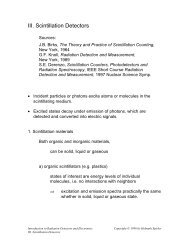Introduction to radiation-resistant semiconductor devices and circuits
Introduction to radiation-resistant semiconductor devices and circuits
Introduction to radiation-resistant semiconductor devices and circuits
Create successful ePaper yourself
Turn your PDF publications into a flip-book with our unique Google optimized e-Paper software.
Since the probability of recombination depends on the transit time through the<br />
junction region, reduced base width will also improve the <strong>radiation</strong> resistance.<br />
Base width is strongly linked with device speed, so that the reduction in DC<br />
current gain βDC scales inversely with a transis<strong>to</strong>r’s unity gain frequency fT . (25)<br />
1 1 Φ<br />
= +<br />
βDC<br />
β0<br />
fT<br />
Since IC technology is driven primarily by device speed, mainstream market<br />
forces will indirectly improve the <strong>radiation</strong> resistance of bipolar transis<strong>to</strong>r processes.<br />
Mid-gap states also limit the low current performance before ir<strong>radiation</strong>.<br />
Over the past decade, evolutionary improvements in contamination control <strong>and</strong><br />
process technology have also yielded substantially better low-current performance.<br />
Measurements on bipolar transis<strong>to</strong>rs from several vendors have shown that processes<br />
not specifically designed for <strong>radiation</strong> resistance are indeed quite usable in<br />
severe <strong>radiation</strong> environments, even at low currents. (26,27,28).<br />
Changes in doping levels have little effect in bipolar transis<strong>to</strong>rs. Typical doping<br />
levels in the base <strong>and</strong> emitter are NB= 10 18 <strong>and</strong> NE= 10 20 cm -3 . In the collec<strong>to</strong>r<br />
depletion region doping levels are smaller, typically 10 16 , rising <strong>to</strong> 10 18 or 10 19 at<br />
the collec<strong>to</strong>r contact. At these levels the change in doping level due <strong>to</strong> displacement<br />
damage (ΔNA ≈ 10 12 cm -3 at Φ= 10 14 cm -2 ) is negligible, although local device<br />
temperatures may be high enough that anti-annealing leads <strong>to</strong> noticeable effects.<br />
DC CURRENT GAIN<br />
100<br />
90<br />
80<br />
70<br />
60<br />
50<br />
40<br />
30<br />
20<br />
10<br />
0<br />
50<br />
NPN PNP<br />
PRE-RAD<br />
POST RAD<br />
10 -5 10 -4 10 -3 10 -2 10 -1 10 0 10 1 10 2 10 3<br />
EMITTER CURRENT DENSITY [μA/(μm) 2 ]<br />
DC CURRENT GAIN<br />
40<br />
30<br />
20<br />
10<br />
0<br />
PRE-RAD<br />
POST-RAD<br />
13<br />
(7)<br />
10 -5 10 -4 10 -3 10 -2 10 -1 10 0 10 1 10 2 10 3<br />
EMITTER CURRENT DENSITY [μA/(μm) 2 ]<br />
FIGURE 4. DC current gain of npn <strong>and</strong> pnp transis<strong>to</strong>rs before <strong>and</strong> after ir<strong>radiation</strong> <strong>to</strong> a<br />
fluence of 1.2⋅10 14 cm -2 (800 MeV pro<strong>to</strong>ns).





